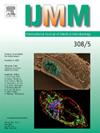The development of an Actinomadura madurae grain model in Galleria mellonella larvae
IF 3.6
3区 医学
Q1 MICROBIOLOGY
引用次数: 0
Abstract
Mycetoma is a neglected tropical disease characterized by large tumorous lesions. It can be caused by fungi (eumycetoma) or bacteria (actinomycetoma). The hallmark of mycetoma is the formation of grains by the causative agent. Grains can only be formed in vivo; therefore, in vivo models are crucial to studying mycetoma. In vivo, grain models have been developed in the invertebrate Galleria mellonella for eumycetoma, but not for actinomycetoma. Here, we aimed to develop the first actinomycetoma grain model in G. mellonella larvae. Actinomadura madurae strains DSM43236 and DSM44005 were used to infect G. mellonella larvae. Larval survival was monitored over 10 days. Grain formation was studied histologically and compared to grains in human tissues. The efficacy of trimethoprim-sulfamethoxazole and amikacin, the current standard treatment for actinomycetoma, was determined. A. madurae infection decreased the survival of G. mellonella larvae in a concentration-dependent manner. Grains were formed within 24 h post-infection. After 72 h these grains became melanised. No significantly enhanced survival was noted with trimethoprim-sulfamethoxazole, amikacin, or a combination thereof. In this model, the melanised A. madurae grains did differ from human grains, most likely due to the immune system of G. mellonella. The lack of therapeutic efficacy could be caused by this melanin or the fact that A. madurae grains, in general, are less susceptible to these drugs. More research will be needed to address this question.
mellonella幼虫中madurae放线瘤颗粒模型的发育。
足菌肿是一种被忽视的热带疾病,其特征是巨大的肿瘤病变。它可以由真菌(真菌瘤)或细菌(放线菌瘤)引起。足菌肿的标志是由病原体形成的颗粒。颗粒只能在体内形成;因此,体内模型对足菌肿的研究至关重要。在活体中,已经在无脊椎动物中建立了针对真菌肿的颗粒模型,但没有针对放线菌肿的颗粒模型。在此,我们的目标是建立第一个放线菌瘤颗粒模型。用放线瘤放线瘤菌株DSM43236和DSM44005分别感染黄颡鱼幼虫。10 d内监测幼虫存活率。从组织学上研究了颗粒的形成,并与人体组织中的颗粒进行了比较。测定放线菌瘤现行标准治疗方法甲氧苄啶-磺胺甲恶唑联合阿米卡星的疗效。棉铃虫感染后,棉铃虫幼虫存活率呈浓度依赖性下降。感染后24 h内形成颗粒。在72 h之后,这些颗粒变黑了。甲氧苄氨嘧啶-磺胺甲恶唑、阿米卡星或其组合没有显著提高生存率。在这个模型中,黑化的麻花麦穗确实不同于人类的麦穗,很可能是由于麻花麦穗的免疫系统。治疗效果的缺乏可能是由这种黑色素引起的,或者是由于马杜拉草颗粒通常对这些药物不太敏感。需要更多的研究来解决这个问题。
本文章由计算机程序翻译,如有差异,请以英文原文为准。
求助全文
约1分钟内获得全文
求助全文
来源期刊
CiteScore
9.70
自引率
0.00%
发文量
18
审稿时长
45 days
期刊介绍:
Pathogen genome sequencing projects have provided a wealth of data that need to be set in context to pathogenicity and the outcome of infections. In addition, the interplay between a pathogen and its host cell has become increasingly important to understand and interfere with diseases caused by microbial pathogens. IJMM meets these needs by focussing on genome and proteome analyses, studies dealing with the molecular mechanisms of pathogenicity and the evolution of pathogenic agents, the interactions between pathogens and host cells ("cellular microbiology"), and molecular epidemiology. To help the reader keeping up with the rapidly evolving new findings in the field of medical microbiology, IJMM publishes original articles, case studies and topical, state-of-the-art mini-reviews in a well balanced fashion. All articles are strictly peer-reviewed. Important topics are reinforced by 2 special issues per year dedicated to a particular theme. Finally, at irregular intervals, current opinions on recent or future developments in medical microbiology are presented in an editorial section.

 求助内容:
求助内容: 应助结果提醒方式:
应助结果提醒方式:


